105 Best ChatGPT Prompts for Different Writing Styles to achieve Success in writing
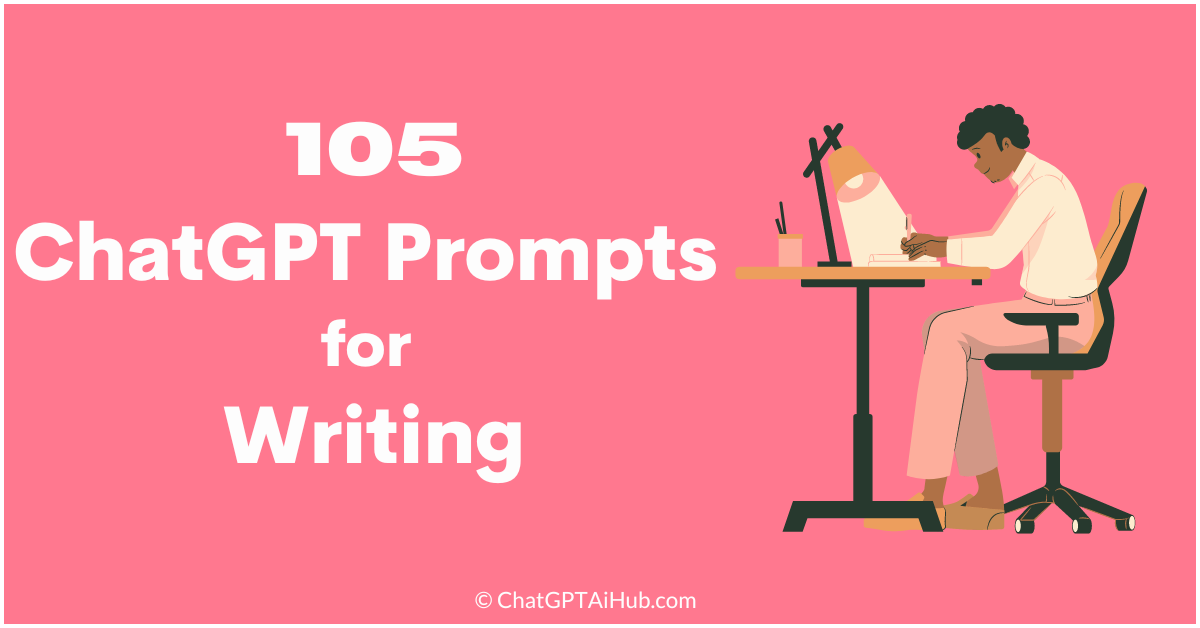
Are you struggling to find the perfect writing prompts to spark your creativity? Look In this blog post, we’ll explore the ChatGPT Prompts for Different Writing Styles, those magical words or sentences that provide you with precisely the results you desire. With the help of ChatGPT, you can Open a treasure Collection of writing ideas tailored to your needs. Discover the best ChatGPT Prompts for Different Writing Styles and watch your imagination soar to new heights. Whether you’re an aspiring writer or a seasoned wordsmith, these prompts will be your secret weapon for unleashing your writing potential. Get ready to dive into the exciting realm of ChatGPT Prompts for Different Writing Styles and ignite your creativity like never before!
Problem Faced – Lack of Writing Inspiration
Many aspiring writers often find themselves struggling with a common challenge: a lack of writing inspiration. Without a spark of creativity, it can be daunting to put pen to paper or fingers to keyboard. This is where ChatGPT Prompts for Different Writing Styles come to the rescue, providing a solution to the writer’s block dilemma. By leveraging the power of ChatGPT, writers can now access a wide range of prompts tailored to their specific needs, Opening a world of limitless ideas and inspiration.
Igniting Creativity – Exploring ChatGPT Prompts for Different Writing Styles
When readers Explore into the world of ChatGPT Prompts for Different Writing Styles, they have high expectations. They anticipate discovering a valuable resource that will spark their creativity, overcome writer’s block, and provide a wealth of writing ideas. By exploring the best ChatGPT prompts for writing, readers will Open a treasure Collection of inspiration, transforming their writing journey and enabling them to unleash their full potential.
Why ChatGPT Prompts for Different Writing Styles Are Important:
ChatGPT Prompts for Different Writing Styles are invaluable tools that enhance the writing experience for individuals across various domains. By providing tailored prompts, they inspire creativity, overcome writer’s block, and assist in generating engaging content. Whether you’re a student, professional, or writing enthusiast, ChatGPT prompts offer a gateway to explore new ideas, improve your writing skills, and achieve success in your writing endeavors.
Essential Components or Parts that Contribute to the Overall Structure and Effectiveness of a Writing
1. Introduction: The introduction is the opening section of a piece of writing, where the writer introduces the topic, grabs the reader’s attention, and provides necessary background information. It often includes a thesis statement or main idea.
2. Body: The body of a written work contains the main content and supports the thesis statement. It is usually divided into paragraphs, each addressing a specific point or idea. The body provides evidence, examples, arguments, and explanations to support the writer’s claims.
3. Conclusion: The conclusion is the closing section of the writing, where the writer summarizes the main points, restates the thesis, and often offers final thoughts or recommendations. It brings the piece to a logical and satisfying end.
4. Thesis Statement: The thesis statement is a clear and concise sentence or two that presents the main idea or argument of the writing. It serves as a guide for the rest of the piece, shaping the content and providing focus.
5. Topic Sentences: Topic sentences appear at the beginning of each paragraph in the body section. They introduce the main point or idea of the paragraph and provide a smooth transition from one idea to the next.
6. Supporting Evidence: Supporting evidence includes facts, statistics, examples, anecdotes, or expert opinions that bolster the writer’s claims and arguments. It helps to convince the reader and adds credibility to the writing.
7. Transitions: Transitions are words, phrases, or sentences that establish connections and create flow between sentences, paragraphs, and ideas. They ensure coherence and help the reader follow the logical progression of the writing.
8. Voice and Tone: Voice refers to the unique style and personality of the writer, while tone refers to the attitude or emotion conveyed in the writing. Both voice and tone contribute to the overall impact and engagement of the piece.
9. Grammar and Punctuation: Proper grammar and punctuation are crucial for effective communication. They ensure clarity, coherence, and readability, allowing the writer’s ideas to be understood correctly.
10. Editing and Revision: Editing and revision involve reviewing and improving the writing by checking for errors, clarifying ideas, refining sentence structures, and polishing the overall presentation. This part helps to enhance the quality and effectiveness of the final piece.
Visit Here: ChatGPT Prompts for Teachers
Best Versatile ChatGPT Prompts for Different Writing Styles That Covers Various Writing Styles
1. “Compose a captivating narrative exploring the theme of [Enter your chosen theme]. Craft compelling characters, build suspense, and create a satisfying resolution to engage and captivate readers.”
2. “Write a persuasive article advocating for [Enter your chosen topic]. Present well-researched arguments, incorporate compelling evidence, and address counterarguments to persuade readers and inspire action.”
3. “Craft an informative blog post on [Enter your chosen topic] that provides valuable insights, expert tips, and in-depth analysis to educate and engage readers. Present information in a clear and engaging manner, ensuring it is accessible to a wide audience.”
4. “Create a descriptive piece capturing the essence of [Enter your chosen subject]. Use vivid imagery, sensory details, and figurative language to transport readers to the setting and evoke emotions.”
5. “Compose a thought-provoking opinion piece discussing the impact of [Enter your chosen subject] on society. Present your unique perspective, support it with logical reasoning and evidence, and encourage readers to contemplate the topic from different angles.”
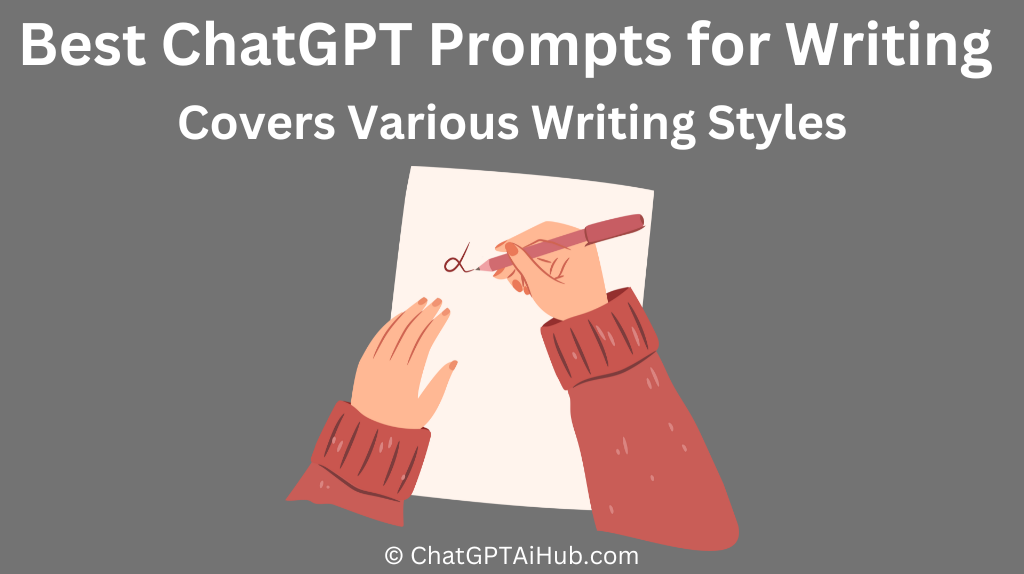
Some Common Types of Writing:
1. Narrative Writing
2. Descriptive Writing
3. Expository Writing
4. Persuasive Writing
5. Argumentative Writing
6. Technical Writing
7. Journalistic Writing
8. Business Writing
9. Academic Writing
10. Creative Writing
1. Narrative Writing:
Step 1: Introduction
“Compose an engaging introduction that captures readers’ attention and introduces the topic of [Enter your topic/query]. Set the tone for your narrative, enticing readers to delve into the story.”
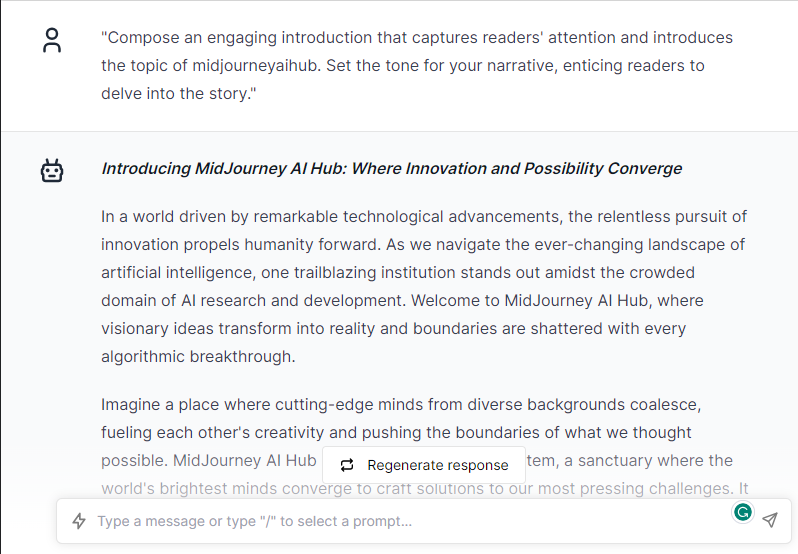
Step 2: Plot
“Develop a well-structured plot that unfolds with a clear beginning, middle, and end. Incorporate your chosen topic of [Enter your topic/query] into the plot, creating a narrative that keeps readers engaged and eager to discover what happens next.”
Step 3: Characters
“Create relatable and well-developed characters that drive the narrative forward. Explore how [Enter your topic/query] influences the personalities, motivations, and relationships of your characters, making them integral to the story.”
Step 4: Setting
“Describe the setting of your narrative, paying attention to the details that enhance the story. Reflect how [Enter your topic/query] shapes the atmosphere, geography, and cultural aspects of the setting, immersing readers in the world you’ve created.”
Step 5: Conflict
“Introduce a compelling conflict that challenges your characters and propels the narrative. Consider how [Enter your topic/query] creates conflicts and obstacles that your characters must overcome, driving the story’s tension and suspense.”
Step 6: Theme
“Explore the underlying theme(s) that your narrative seeks to convey. Reflect on how [Enter your topic/query] intertwines with the themes of your story, provoking deeper insights and reflections for readers.”
Step 7: Point of View
“Choose a specific point of view that best serves your narrative. Consider how [Enter your topic/query] influences the perspective through which the story is told, shaping readers’ understanding and connection to the events.”
Step 8: Dialogue
“Craft authentic and engaging dialogue that brings your characters to life. Explore how [Enter your topic/query] influences the conversations and interactions among characters, adding depth and realism to their relationships.”
Step 9: Descriptive Language
“Utilize descriptive language to create vivid imagery and sensory experiences for readers. Incorporate elements related to [Enter your topic/query] in your descriptions, engaging readers’ senses and immersing them in the story.”
Step 10: Resolution
“Conclude your narrative with a satisfying resolution that addresses the conflicts and provides closure. Reflect on how [Enter your topic/query] plays a role in the resolution, offering insights, growth, or lessons learned throughout the story.”
Note: Please replace [Enter your topic] with your specific topic or subject in each prompt.
2. Descriptive Writing:
Step 1: Sensory Details:
“Incorporate sensory details such as sights, sounds, smells, tastes, and textures to create a vivid description of [Enter your subject]. Engage the reader’s senses and transport them to the experience through your words.”
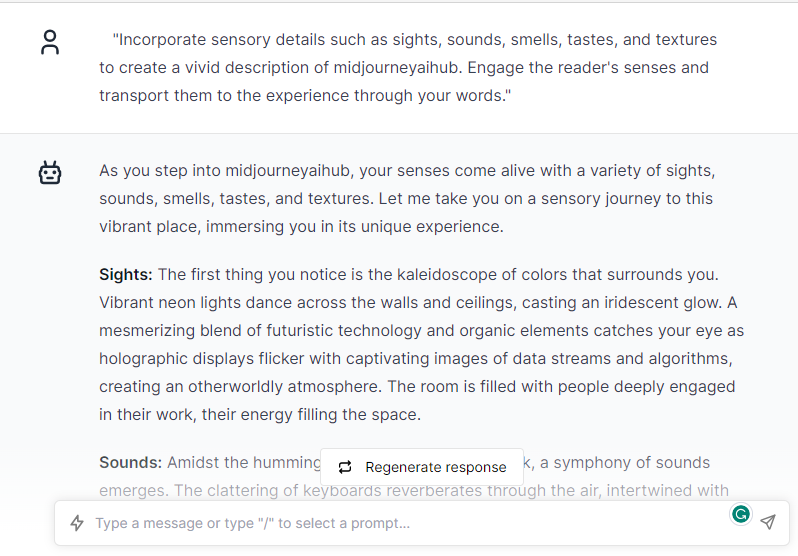
Step 2: Figurative Language:
“Utilize figurative language techniques such as metaphors, similes, personification, or hyperbole to enhance your description of [Enter your subject]. Employ creative comparisons to bring depth and richness to your writing.”
Step 3: Vivid Imagery:
“Create vivid imagery by using descriptive language to paint a clear picture of [Enter your subject]. Engage the reader’s imagination through evocative details that make the scene or object come alive in their mind.”
Step 4: Use of Adjectives and Adverbs:
“Employ carefully chosen adjectives and adverbs to enhance your description of [Enter your subject]. Select words that precisely convey the qualities, characteristics, and actions of the subject, adding depth and specificity to your writing.”
Step 5: Organization and Structure:
“Organize your description in a logical and coherent manner. Consider using a spatial or chronological structure to guide the reader through the subject, allowing for a clear and cohesive presentation of details.”
Step 6: Word Choice:
“Carefully select your words to effectively convey the desired tone and evoke the intended emotions in your description of [Enter your subject]. Consider the connotations and nuances of different words to create the desired impact.”
Step 7: Tone and Mood:
“Establish the tone and mood of your description by choosing words, phrases, and details that create a specific atmosphere. Reflect on the emotions and impressions you wish to evoke in the reader.”
Step8. Point of View:
“Determine the most effective point of view for your description of [Enter your subject]. Consider how the choice of first-person, second-person, or third-person perspective can shape the reader’s experience and connection with the subject.”
Step9. Specificity and Detail:
“Provide specific and detailed information in your description of [Enter your subject]. Focus on unique features, characteristics, and sensory observations to create a more engaging and immersive experience for the reader.”
Step10. Use of Metaphors and Similes:
“Incorporate metaphors and similes to add depth and create vivid comparisons in your description of [Enter your subject]. Use imaginative language to draw connections and enhance the reader’s understanding and perception.”
Note: Please replace [Enter your topic] with your specific topic or subject in each prompt.
3. Expository Writing:
Step 1: Introduction:
“Write an engaging introduction that captures the reader’s attention and provides an overview of the topic [Enter your topic]. Set the context and introduce the main idea or concept you will be explaining in your expository writing.”

Step 2: Thesis Statement:
“Craft a clear and concise thesis statement that presents the main argument or point you will be addressing in your expository writing about [Enter your topic]. Ensure that your thesis statement reflects the central focus of your explanation.”
Step 3: Supporting Evidence:
“Gather relevant and credible evidence about [Enter your topic] to support your thesis statement. Conduct research, cite reliable sources, and present facts, statistics, or expert opinions that reinforce your explanation.”
Step 4: Analysis and Interpretation:
“Analyze and interpret the evidence you have presented about [Enter your topic], explaining its significance and relevance to your thesis statement. Provide thoughtful insights and explanations to help the reader understand the information you are presenting.”
Step 5: Logical Organization:
“Organize your expository writing about [Enter your topic] in a logical and coherent manner. Use clear headings or subheadings to separate different sections or topics, ensuring a smooth flow of ideas from one point to the next.”
Step 6: Transitions:
“Utilize transitional words and phrases to create smooth transitions between paragraphs and sections of your expository writing about [Enter your topic]. These transitions help guide the reader through your explanation and maintain the overall coherence of your work.”
Step 7: Clarity and Conciseness:
“Write with clarity and conciseness to ensure that your explanation about [Enter your topic] is easily understood. Use clear language, avoid jargon or unnecessary complexity, and present your ideas in a straightforward manner.”
Step 8: Examples and Illustrations:
“Include relevant examples, illustrations, or case studies about [Enter your topic] to clarify and enhance your explanation. Use concrete and specific instances to illustrate your points and help the reader grasp the concepts you are discussing.”
Step 9: Counterarguments and Rebuttals:
“Acknowledge and address potential counterarguments or opposing viewpoints about [Enter your topic]. Present counterarguments in a fair and unbiased manner, and provide rebuttals or counterpoints to strengthen your own argument or explanation.”
Step 10: Conclusion:
“Conclude your expository writing about [Enter your topic] by summarizing the main points you have discussed and restating your thesis statement. Provide a concise and thoughtful conclusion that leaves a lasting impression on the reader.”
Note: Please replace [Enter your topic] with your specific topic or subject in each prompt.
4. Persuasive Writing:
Step 1: Introduction:
“Write a compelling introduction that grabs the reader’s attention and introduces the topic of [Enter your persuasive topic]. Clearly state your stance or position on the topic and establish the purpose of your persuasive writing.”

Step 2: Thesis Statement:
“Craft a strong and concise thesis statement that clearly expresses your main argument or position on [Enter your persuasive topic]. Make sure your thesis statement reflects the central point you want to persuade the reader to accept.”
Step 3: Background Information:
“Provide relevant background information about [Enter your persuasive topic] to help the reader understand the context and significance of the issue. Present facts, statistics, or historical context that support your persuasive argument.”
Step 4: Supporting Evidence:
“Gather compelling evidence, examples, or logical reasoning to support your position on [Enter your persuasive topic]. Use reliable sources, data, research findings, or expert opinions to strengthen your persuasive arguments.”
Step 5: Counter Arguments:
“Address potential counterarguments or opposing viewpoints related to [Enter your persuasive topic]. Acknowledge alternative perspectives and present them fairly, then counter with strong evidence or reasoning to refute them.”
Step 6: Emotional Appeals:
“Incorporate emotional appeals to engage the reader’s emotions and foster empathy or connection to the topic. Use storytelling, personal anecdotes, or vivid language to evoke emotional responses that support your persuasive argument.”
Step 7: Logical Appeals:
“Utilize logical appeals to present clear and rational arguments for [Enter your persuasive topic]. Employ logical reasoning, cause-and-effect relationships, and well-structured arguments that demonstrate the validity of your position.”
Step 8: Credible Sources:
“Refer to credible and authoritative sources that lend credibility to your persuasive writing on [Enter your persuasive topic]. Cite experts, research studies, or reputable organizations to enhance the reliability and validity of your arguments.”
Step 9: Rebuttal of Counterarguments:
“Provide a strong rebuttal to counterarguments against your position on [Enter your persuasive topic]. Anticipate and address potential objections, offering convincing counterpoints supported by evidence or reasoning.”
Step 10: Conclusion:
“Conclude your persuasive writing by summarizing your main points, restating your thesis statement, and reinforcing the importance of your position on [Enter your persuasive topic]. Leave the reader with a call to action or a thought-provoking statement that inspires further consideration.”
Note: Please replace [Enter your persuasive topic] with your specific topic or issue in each prompt.
5. Argumentative Writing:
Step 1: Introduction:
“Write an engaging introduction that presents the topic of [Enter your argumentative topic]. Clearly state the issue or problem, provide relevant background information, and present your main claim or thesis statement.”
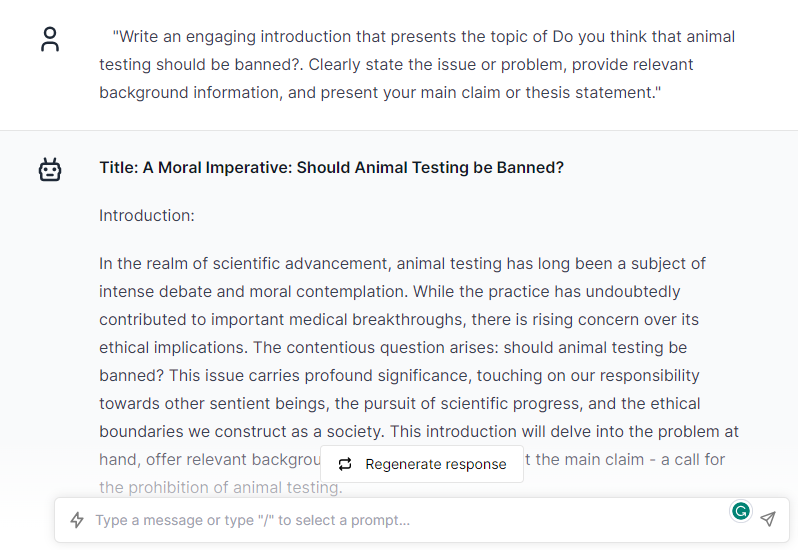
Step 2: Thesis Statement:
“Craft a clear and concise thesis statement that expresses your main argument or position on [Enter your argumentative topic]. Ensure that your thesis statement reflects the central point you want to argue and persuade the reader to accept.”
Step 3: Background Information:
“Provide necessary background information about [Enter your argumentative topic] to help the reader understand the context and significance of the issue. Present facts, statistics, or historical context that establish the need for your argument.”
Step 4: Supporting Evidence:
“Gather strong supporting evidence, facts, examples, or expert opinions to bolster your argument on [Enter your argumentative topic]. Use credible sources and logical reasoning to build a convincing case for your position.”
Step 5: Counter Arguments:
“Address potential counterarguments or opposing viewpoints related to [Enter your argumentative topic]. Present alternative perspectives fairly and then counter with strong evidence or reasoning to refute them.”
Step 6: Logical Reasoning:
“Utilize logical reasoning and sound arguments to support your position on [Enter your argumentative topic]. Present a clear line of thought, use cause-and-effect relationships, and build a logical progression of ideas to strengthen your argument.”
Step 7: Credible Sources:
“Refer to credible and authoritative sources that lend credibility to your argumentative writing on [Enter your argumentative topic]. Cite experts, research studies, or reputable organizations to enhance the reliability and validity of your arguments.”
Step 8: Ethical Considerations:
“Discuss the ethical implications or considerations related to [Enter your argumentative topic]. Explore the moral dimensions of the issue and demonstrate how your argument aligns with ethical principles or societal values.”
Step 9: Rebuttal of Counter Arguments:
“Provide a strong rebuttal to counterarguments against your position on [Enter your argumentative topic]. Anticipate and address potential objections, offering convincing counterpoints supported by evidence or reasoning.”
Step 10: Conclusion:
“Conclude your argumentative writing by summarizing your main points, restating your thesis statement, and reinforcing the importance of your position on [Enter your argumentative topic]. Leave the reader with a thought-provoking statement or call to action that encourages further consideration.”
Note: Please replace [Enter your argumentative topic] with your specific topic or issue in each prompt.
6. Technical Writing:
Step 1: Identify the Audience:
“Determine the target audience of your technical writing [Enter your query or topic]. Consider their knowledge level, background, and specific needs in order to tailor your writing to effectively communicate with them.”
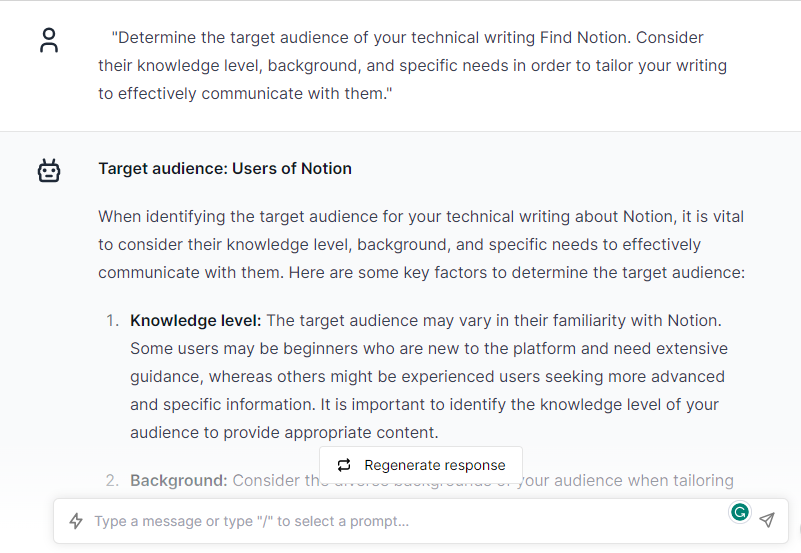
Step 2: Define the Purpose:
“Clearly define the purpose of your technical writing [Enter your query or topic]. Specify whether you aim to instruct, inform, explain, troubleshoot, or persuade the audience, ensuring that your writing aligns with this purpose.”
Step 3: Gather Information:
“Conduct thorough research and gather accurate information related to [Enter your query or topic]. Consult reliable sources, experts, and any available documentation to ensure the accuracy and completeness of your technical writing.”
Step 4: Organize the Content:
“Organize your technical writing [Enter your query or topic] in a logical and coherent manner. Use headings, subheadings, bullet points, or numbered lists to structure your information and make it easily navigable for the reader.”
Step 5: Use Clear and Concise Language:
“Write in clear and concise language to ensure that your technical writing [Enter your query or topic] is easily understood. Use precise terminology, avoid jargon or unnecessary technical terms, and provide definitions or explanations when needed.”
Step 6: Provide Step-by-Step Instructions:
“If applicable to your topic, provide clear and detailed step-by-step instructions [Enter your query or topic]. Break down complex processes into manageable steps, using numbered lists or visual aids to guide the reader through each stage.”
Step 7: Include Visuals and Graphics:
“Enhance your technical writing [Enter your query or topic] by incorporating relevant visuals and graphics. Use diagrams, charts, tables, or illustrations to illustrate complex concepts, data, or procedures for better understanding.”
Step 8: Focus on Accuracy and Precision:
“Pay meticulous attention to accuracy and precision in your technical writing [Enter your query or topic]. Use precise measurements, specifications, or technical details to ensure the reliability and correctness of the information presented.”
Step 9: Address Common Issues or Errors:
“Anticipate and address common issues or errors related to [Enter your query or topic] in your technical writing. Provide troubleshooting tips, FAQs, or troubleshooting guides to help readers overcome common challenges.”
Step 10: Review and Revise:
“Thoroughly review and revise your technical writing [Enter your query or topic] to ensure clarity, accuracy, and effectiveness. Check for grammar, spelling, and formatting errors, and consider seeking feedback from subject matter experts or colleagues.”
Note: Please replace [Enter your query or topic] with your specific query or topic in each prompt.
7. Journalistic Writing:
Step 1: Identify the News Angle:
“Identify the news angle of [Enter your topic]. Determine the most newsworthy aspect or event that you will focus on in your journalistic writing. Consider the timeliness, relevance, and significance of the topic.”

Step 2: Craft a Compelling Headline:
“Create a compelling and attention-grabbing headline for your journalistic piece on [Enter your topic]. Summarize the main news point or highlight an intriguing aspect to entice readers to engage with your article.”
Step 3: Write a Captivating Lead:
“Write a captivating lead paragraph that encapsulates the essence of the news story on [Enter your topic]. Hook readers with a concise and engaging introduction that highlights the key facts or key point of interest.”
Step 4: Provide Relevant Background Information:
“Offer relevant background information about [Enter your topic] to provide context and help readers understand the broader context of the news story. Include necessary details, historical background, or relevant statistics.”
Step 5: Include Key Facts and Details:
“Present the key facts, details, or evidence related to [Enter your topic] in a clear and concise manner. Ensure accuracy and objectivity, providing verifiable information from credible sources.”
Step 6: Incorporate Quotes and Interviews:
“Incorporate quotes from relevant sources or conduct interviews with experts, witnesses, or individuals involved in [Enter your topic]. Use direct quotes to add credibility and provide different perspectives.”
Step 7. Address Different Viewpoints:
“Address different viewpoints or perspectives related to [Enter your topic]. Present contrasting opinions or responses to the news story, providing a balanced and fair representation of various viewpoints.”
Step 8: Use a Structured Format:
“Organize your journalistic writing on [Enter your topic] using a structured format. Use clear sections or headings to separate different aspects of the story, such as background information, key events, quotes, and analysis.”
Step 9: Analyze the Impact and Implications:
“Analyze the impact and implications of [Enter your topic]. Examine the broader significance, consequences, or potential outcomes of the news story, helping readers understand the significance and relevance of the events.”
Step 10: Conclude with a Summary or Call to Action:
“Conclude your journalistic writing on [Enter your topic] with a concise summary of the key points or a call to action for readers. Encourage further engagement, reflection, or action based on the information presented.”
Note: Please replace [Enter your topic] with your specific topic or news story in each prompt.
8. Business Writing:
Step 1: Define the Purpose and Audience:
“Define the purpose and target audience of your business writing on [Enter your topic]. Determine whether you are writing for internal stakeholders, clients, or a specific business purpose, and tailor your writing accordingly.”
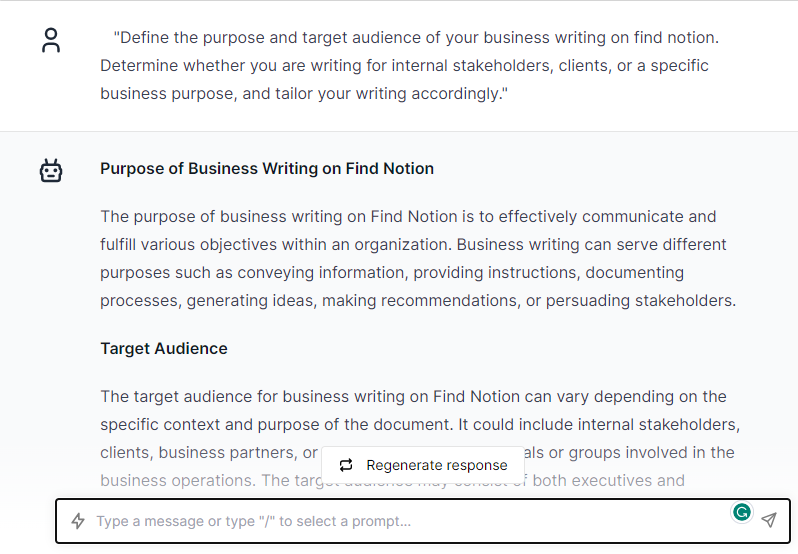
Step 2: Establish Clear Objectives:
“Establish clear objectives for your business writing on [Enter your topic]. Define what you aim to achieve with your communication, such as informing, persuading, requesting, or providing updates.”
Step 3: Use a Professional Tone:
“Maintain a professional and appropriate tone throughout your business writing on [Enter your topic]. Use clear and concise language, avoid jargon, and maintain a respectful and professional demeanor in your writing.”
Step 4: Structure your Writing:
“Organize your business writing on [Enter your topic] in a logical and coherent manner. Use headings, subheadings, bullet points, or numbered lists to present information or ideas in a structured and easy-to-follow format.”
Step 5: Provide Clear and Concise Information:
“Provide clear and concise information about [Enter your topic] in your business writing. Communicate your message effectively, avoiding unnecessary details or complex language that may hinder understanding.”
Step 6: Support Claims with Evidence:
“Support your claims or statements with relevant evidence, data, or examples related to [Enter your topic]. Provide supporting facts or research findings that bolster the credibility and persuasiveness of your writing.”
Step 7: Use Professional Language and Formatting:
“Utilize professional language and formatting conventions in your business writing on [Enter your topic]. Follow standard business writing guidelines, including proper grammar, punctuation, and formatting.”
Step 8: Address Key Stakeholders’ Needs:
“Consider the needs and expectations of key stakeholders in your business writing on [Enter your topic]. Tailor your communication to address their concerns, priorities, or interests to ensure your writing is relevant and impactful.”
Step 9: Call to Action or Next Steps:
“Include a clear call to action or next steps in your business writing on [Enter your topic]. Specify what you expect the reader to do or how they can move forward based on the information provided.”
Step 10: Review and Edit:
“Thoroughly review and edit your business writing on [Enter your topic] to ensure clarity, accuracy, and professionalism. Check for grammar, spelling, and formatting errors, and consider seeking feedback from colleagues or proofreaders.”
Note: Please replace [Enter your topic] with your specific topic or subject in each prompt.
9. Academic Writing:
Step 1: Select a Research Topic:
“Choose a research topic [Enter your topic] that aligns with your academic field or assignment requirements. Consider the significance, relevance, and feasibility of the topic for your academic writing.”

Step 2: Conduct Literature Review:
“Conduct a thorough literature review on [Enter your topic] to explore existing scholarly work. Identify key theories, concepts, or arguments in the field, and analyze how they relate to your research topic.”
Step 3: Define Research Objectives:
“Clearly define the research objectives of your academic writing on [Enter your topic]. Specify what you aim to accomplish, such as filling a research gap, testing a hypothesis, or analyzing a specific phenomenon.”
Step 4: Develop a Thesis Statement:
“Craft a well-defined thesis statement that presents the main argument or research question of your academic writing on [Enter your topic]. Ensure that your thesis statement reflects the purpose and scope of your study.”
Step 5: Conduct Empirical Research (if applicable):
“If conducting empirical research on [Enter your topic], design and implement a research methodology that aligns with the objectives of your study. Collect and analyze relevant data using appropriate research methods.”
Step 6: Organize your Writing:
“Organize your academic writing on [Enter your topic] in a clear and coherent structure. Use sections, subheadings, and logical transitions to present your introduction, literature review, methodology, findings, and conclusions.”
Step 7: Support Arguments with Evidence:
“Support your arguments, claims, or findings with credible evidence, data, or scholarly sources related to [Enter your topic]. Use in-text citations and provide a comprehensive list of references in the appropriate citation style.”
Step 8: Analyze and Interpret Results:
“Analyze and interpret the results or findings of your academic research on [Enter your topic]. Use appropriate data analysis techniques, models, or frameworks to derive meaningful insights from your data.”
Step 9: Discuss Implications and Significance:
“Discuss the implications and significance of your findings on [Enter your topic]. Analyze how your research contributes to the existing body of knowledge, identifies new avenues for research, or informs practice in the field.”
Step 10: Conclude with Critical Reflection:
“Conclude your academic writing on [Enter your topic] by summarizing the main points, restating the thesis statement, and providing a critical reflection on the limitations and future directions of your research.”
Note: Please replace [Enter your topic] with your specific topic or research area in each prompt.
Visit Here: ChatGPT Prompts for Academic Writing
10. Creative Writing:
Step 1: Choose a Creative Writing Topic:
“Choose a creative writing topic [Enter your topic] that inspires you and aligns with your interests or goals. Consider the genre, theme, or specific aspect you want to explore in your creative writing.”

Step 2: Develop Compelling Characters:
“Develop compelling characters for your creative writing [Enter your topic]. Create unique personalities, backgrounds, and motivations that will drive the narrative and engage the reader.”
Step 3: Establish a Vivid Setting:
“Establish a vivid and immersive setting for your creative writing [Enter your topic]. Describe the time, place, and atmosphere with sensory details, capturing the essence of the environment.”
Step 4: Create an Engaging Plot:
“Create an engaging and well-structured plot for your creative writing [Enter your topic]. Develop a clear beginning, middle, and end, incorporating conflict, tension, and resolution to keep the reader engaged.”
Step 5: Craft Dialogue:
“Craft realistic and engaging dialogue for your creative writing [Enter your topic]. Give each character a distinct voice and use dialogue to reveal their personalities, advance the plot, and create engaging interactions.”
Step 6: Utilize Descriptive Language:
“Utilize descriptive language to paint vivid imagery in your creative writing [Enter your topic]. Engage the reader’s senses with evocative details, allowing them to immerse themselves in the story.”
Step 7: Experiment with a Narrative Point of View:
“Experiment with different narrative points of view in your creative writing [Enter your topic]. Consider using first-person, third-person limited, or omniscient perspectives to shape the reader’s experience.”
Step 8: Incorporate Literary Devices:
“Incorporate literary devices, such as metaphors, similes, symbolism, or foreshadowing, into your creative writing [Enter your topic]. Use these devices to add depth, layers of meaning, and intrigue to your story.”
Step 9: Maintain a Consistent Tone:
“Maintain a consistent tone throughout your creative writing [Enter your topic]. Whether it’s light-hearted, suspenseful, or contemplative, ensure that the tone aligns with the overall mood and themes of your story.”
Step 10: Edit and Revise:
“Edit and revise your creative writing [Enter your topic] to refine the plot, characters, and language. Ensure coherence, clarity, and flow in your story, and seek feedback from others to improve your work.”
Note: Please replace [Enter your topic] with your specific creative writing topic or idea in each prompt.
Visit Here: ChatGPT Prompts
Get 105+ Best ChatGPT Prompts for Writing- Complete List Here!
Free Prompts forever – Complete Writing Prompts List

Final Thought:
In conclusion, ChatGPT Prompts for Different Writing Styles revolutionize the creative process, providing a wellspring of inspiration and overcoming writer’s block. Whether you’re a student, professional, or writing enthusiast, these prompts unlock a world of possibilities, enhancing your skills and unleashing your full writing potential. Embrace the power of ChatGPT Prompts for Different Writing Styles and witness your ideas come to life with newfound creativity and clarity. Let the magic of ChatGPT prompts ignite your imagination and elevate your writing to extraordinary heights.
What is the Best Prompt for ChatGPT?
The best prompt for ChatGPT is one that clearly defines the desired task or question while providing sufficient context for the model to generate a relevant and accurate response.
How do I write better ChatGPT Prompts?
To write better ChatGPT prompts, be clear and specific about the desired outcome or information you seek, and provide relevant context to guide the model’s response.
What are Prompts in ChatGPT?
Prompts in ChatGPT are inputs provided to the model that specifies the desired task, question, or context for generating a response.
What are good writing Prompts?
Good writing prompts are engaging and thought-provoking statements or questions that inspire creativity and encourage meaningful exploration of ideas.
What should I ask in ChatGTP?
In ChatGPT, you should ask clear and specific questions or provide concise instructions to obtain the desired information or response from the model.
How do I write in ChatGPT?
To write in ChatGPT, simply provide your input or question as a clear and concise statement or prompt, and the model will generate a response based on that input.
How can I start a Prompt?
To start a prompt, clearly state your question or provide concise instructions for the desired response from ChatGPT.
How should I start a Prompt?
Start a prompt by clearly stating your query or providing concise instruction, ensuring it is specific and provides relevant context for ChatGPT to generate a meaningful response.
How long can ChatGPT Prompts be?
ChatGPT prompts can typically be several sentences long, but it is generally recommended to keep them concise and within a reasonable length to ensure clarity and effective communication.
What is an easy Prompt?
“Can you explain the concept of artificial intelligence in simple terms?”

